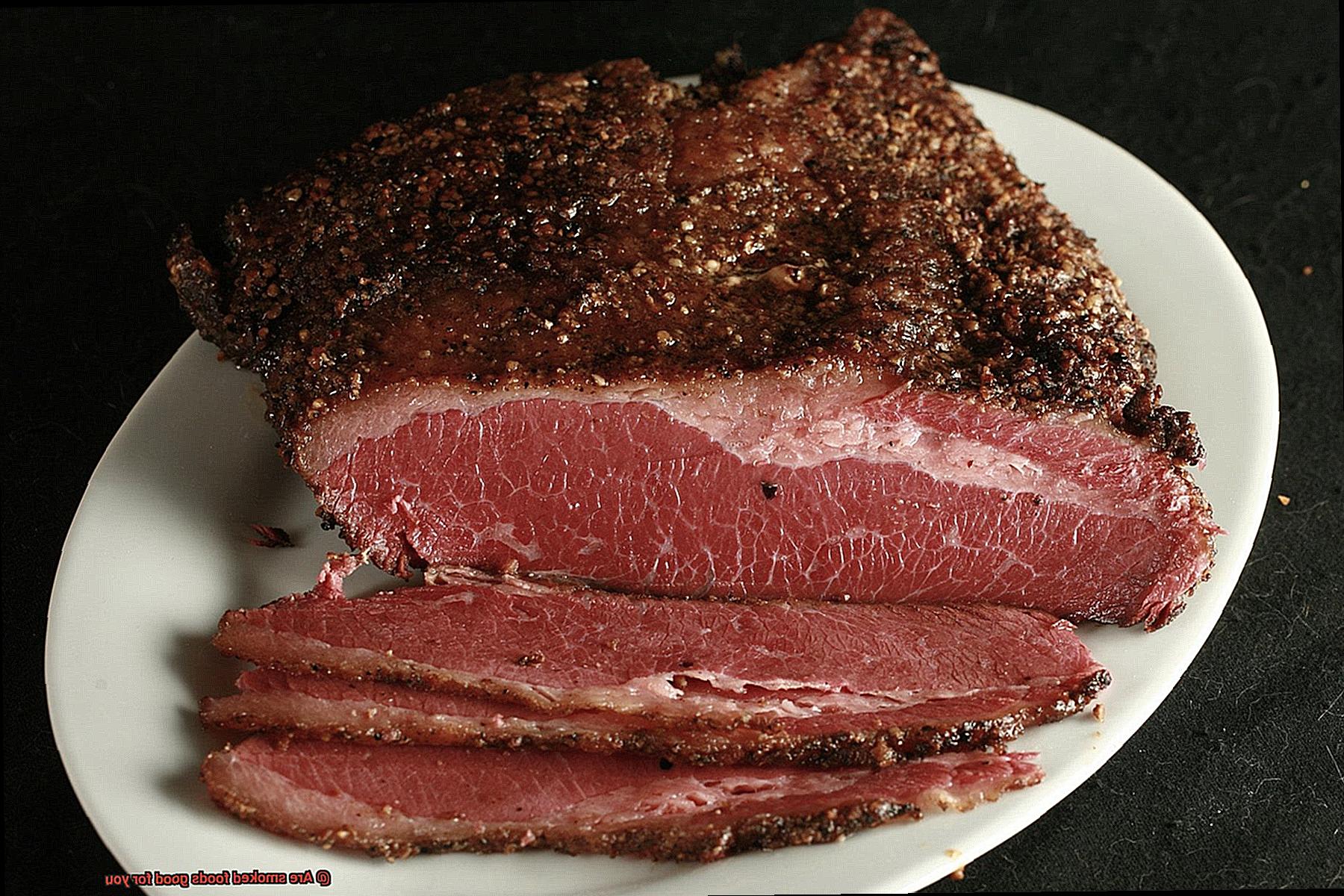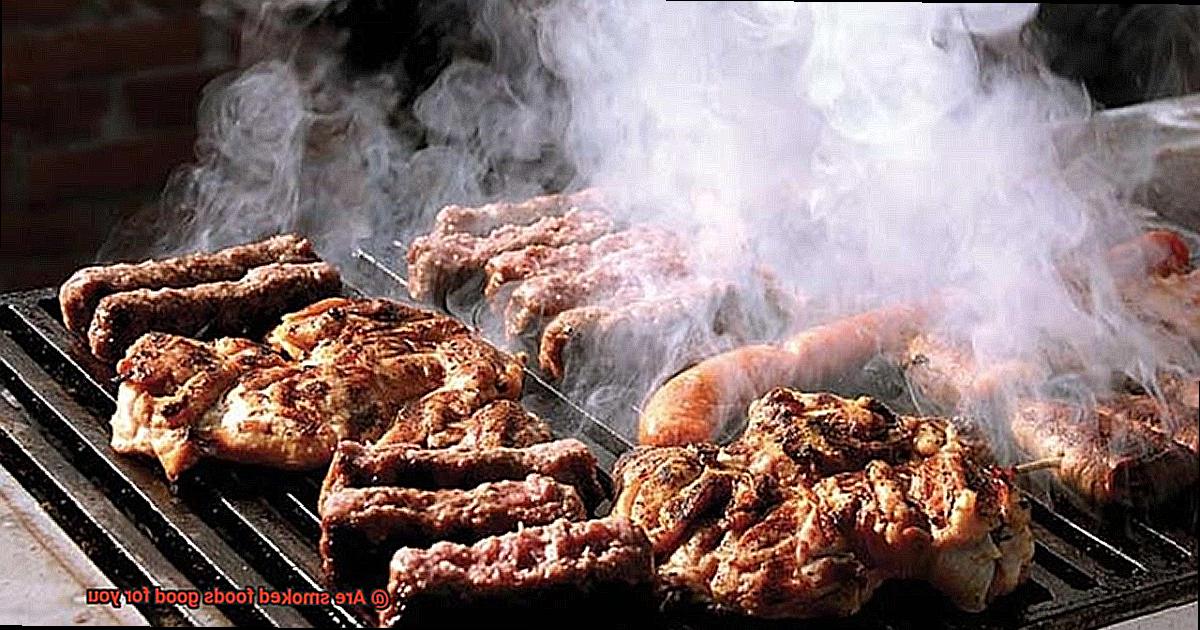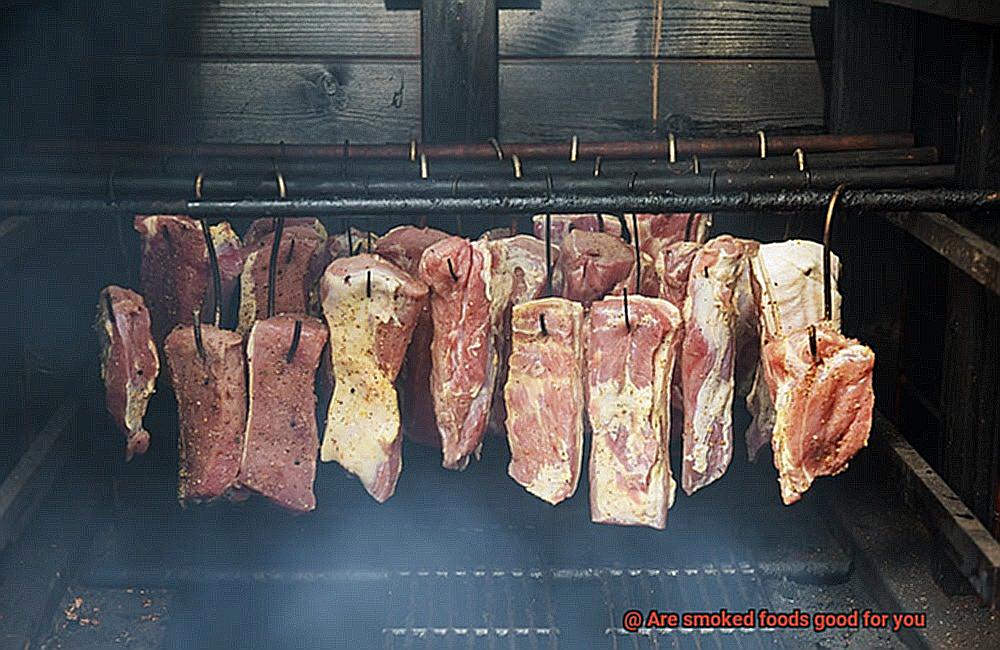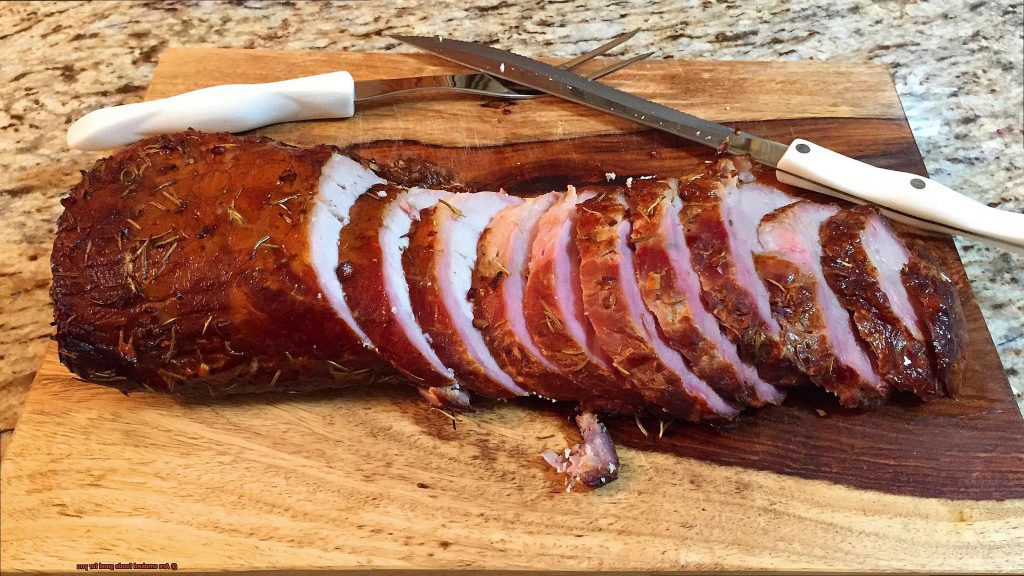Get ready to sink your teeth into a sizzling discussion that’ll leave you craving answers. Today, we’re diving headfirst into the smoky world of smoked foods and tackling the age-old question: are they truly good for you?
Picture this: you’re cozied up by a crackling bonfire, mouthwatering scents of smoked delicacies wafting through the air. It’s hard to resist the allure of those perfectly charred meats and veggies, but what lies beneath that tempting flavor? Are we indulging in gastronomic bliss or playing with potential health hazards?
Join me on this tantalizing journey as we explore the pros and cons of diving into the decadent pleasure of smoke-infused cuisine. To fully appreciate this complex topic, we need to consider both the benefits and drawbacks lurking within that smoky haze.
First up, let’s uncover the captivating history behind smoking foods – a tradition deeply rooted in ancient cultures across the globe. From Native American tribes to bold European explorers, smoking has been used as a preservation technique, adding depth and smoky richness to an array of ingredients.
But is this fiery dance between wood and food simply a culinary fling, or does it come with hidden health risks? We’ll dig into scientific research and expert opinions to unravel truths and debunk some common myths surrounding smoked foods.
We’ll also take a closer look at potential downsides like the formation of harmful chemical compounds during the smoking process – compounds that may have carcinogenic effects. Plus, we’ll examine how smoked foods can impact heart health and pose challenges for those with pre-existing conditions.
So buckle up, fellow food adventurers. We’re embarking on a mouthwatering exploration of all things smoked – from the pros to the cons and everything in between. Get ready to devour the facts, feast on knowledge, and make informed choices. Remember, the key is finding that perfect balance between indulgence and well-being.
Stay tuned for future blog posts where we’ll shed light on the nutritional contributions of smoked foods and dish out tips to navigate the smoky landscape safely. Get ready to satisfy your cravings without sacrificing your health.
Contents
Potential Health Risks of Eating Smoked Foods
The allure of smoked foods is undeniable, with their tantalizing flavors and captivating aromas. However, beneath their delectable exterior lies a potential health hazard that cannot be ignored. This article explores the myriad of health risks associated with indulging in smoked foods, ranging from the formation of carcinogenic compounds to high sodium content and increased fat levels. Let us delve into the smoke-filled world of potential dangers and uncover ways to safeguard our well-being.
Formation of Harmful Compounds:
The very process that imparts smoky goodness to our favorite foods can also give rise to dangerous compounds. Polycyclic aromatic hydrocarbons (PAHs) and heterocyclic amines (HCAs) are produced when wood or charcoal is burned during smoking. PAHs cling to the food’s surface when fats and juices drip onto hot coals, while HCAs form when proteins react to intense heat. Excessive intake of these compounds has been linked to various cancers, including lung, stomach, and colorectal cancer.
Sodium Content:
Indulging in smoked foods often means subjecting ourselves to hidden sodium bombs. The smoking process frequently involves the use of salt, enhancing flavor and acting as a preservative. However, excessive sodium consumption can lead to high blood pressure and an increased risk of heart disease. To protect our cardiovascular health, moderation is key, balancing smoked treats with low-sodium alternatives.
Surging Fat Levels:
As smoke permeates through meat, it causes fat to melt and absorb more flavor. Consequently, smoked foods may harbor higher fat levels compared to other cooking methods. While fat is crucial for our bodies, overconsumption of saturated or trans fat can have detrimental effects on our hearts. Opting for lean cuts of meat and diligently removing visible fat prior to smoking can help mitigate the overall fat content of smoked foods.

Nitrosamines:
The inclusion of cured meats in smoked food preparations introduces another health risk. Nitrates or nitrites, common ingredients in cured meats, can react with smoke components, resulting in the formation of nitrosamines. These insidious compounds are notorious for their carcinogenic properties and have been associated with stomach and esophageal cancer. It is prudent to moderate the consumption of smoked foods containing cured meats and explore healthier alternatives whenever possible.
The Formation of Harmful Compounds During Smoking
Ah, the tantalizing aroma of smoked meat, beckoning us to indulge in its flavorful allure. But before we succumb to the smoky temptation, let us unveil the dark side of smoking, where potential health hazards lurk beneath its seductive exterior. In this section, we will embark on a journey through the captivating world of smoking and uncover the formation of harmful compounds that threaten our well-being.
The Smoking Process and Chemical Reactions:
When food meets smoke, a grand symphony of chemical reactions commences. Fats and proteins within the food begin their mesmerizing breakdown, a transformation that gives birth to the notorious polycyclic aromatic hydrocarbons (PAHs). Picture fat sizzling on hot coals or wood chips burning, releasing smoke laced with these perilous compounds – a cacophony that shatters our culinary delight.
The Culprits: Polycyclic Aromatic Hydrocarbons (PAHs):
PAHs, the puppet masters of harm, spare no mercy. Carcinogenic by nature, they pose an ominous threat to our health. From colon to stomach and pancreatic cancers, PAHs dance with danger. The levels of PAHs formed during smoking fluctuate based on temperature, cooking time, and the type of meat or fish embraced by the smoke. Vigilance amidst these variables becomes paramount for safeguarding our well-being.

Enter Heterocyclic Amines (HCAs):
Now let us unmask the sinister accomplices of PAHs – heterocyclic amines (HCAs). Born from the heated union of amino acids and creatine in meat and fish, HCAs emerge as formidable foes. Their presence raises the specter of cancer, haunting the colon, stomach, and pancreas. The intensity of HCA formation hinges upon temperature, cooking time, and the type of meat or fish embraced by the smoky embrace. With these variables in mind, we navigate the treacherous path towards health preservation.
High Sodium Levels in Smoked Foods
Prepare yourselves for a journey into the smoky realm of smoked foods, where flavors dance and aromas tantalize. But beware, hidden within this haze lies a dangerous secret – high sodium levels. So buckle up and get ready for a salty adventure like no other.
The Smoking Process and Sodium:
In our previous exploration, we uncovered the captivating allure of smoked foods. But what truly gives these delicacies their addictive qualities? Well, the answer lies in more than just dancing flavors and aromatic compounds. Salt plays a significant role in the smoking process.
When food is exposed to smoke from burning wood or charcoal, it absorbs some of the smoke components, including salt particles. This salt not only enhances flavor but also acts as a natural preservative by inhibiting the growth of bacteria and microorganisms.
The Sodium Conundrum:

Alas, this love affair between smoke and salt comes at a cost – high sodium levels in smoked foods. Compared to their non-smoked counterparts, these delectable treats pack a salty punch. And excessive sodium intake can lead to health problems like high blood pressure, heart disease, stroke, and kidney disease. It’s a dilemma we must address.
Tips to Reduce Sodium Intake from Smoked Foods:
Choose Wisely:
Not all smoked foods are created equal when it comes to sodium content. Seek out lower-sodium alternatives that boast reduced levels or no added salt options.
Size Matters:
In this salty sea, portion control is your compass. Keep your intake of smoked foods in check by enjoying smaller portions that still allow you to savor their unique flavors.
Lean and Mean:
When selecting smoked meats or fish, opt for lean cuts that offer lower sodium levels compared to their fattier counterparts. Your taste buds and heart will thank you.
Watch Out for Extras:

Some smoked foods undergo additional salting processes before smoking, elevating their sodium content. Stay vigilant and consider alternative options that don’t pack an extra salty punch.
Health Conditions and Caution:
If you have existing health conditions like high blood pressure or kidney disease, exercise caution when indulging in smoked foods. The high sodium levels might not play well with your well-being. Consult your healthcare provider for personalized advice.
Higher Fat Content in Smoked Foods
Step into a world where flavor reigns supreme and aromas weave a tantalizing spell. But beware, for within the smoky embrace of your favorite foods lies an unspoken truth – higher fat content. In this section, we will delve into the depths of this sizzling phenomenon and uncover the reasons behind why smoked foods often come with an unwanted sidekick called fat. Get ready to explore this rich and flavorful journey.
Unmasking the Culprit: The Smoking Process and the Art of Fat Infusion
As we venture into the realm of smoked foods, it becomes evident that they possess a higher fat content compared to their non-smoked counterparts. But what lies beneath this smoky allure? Let us unravel the secrets.
Low and Slow: A Symphony for the Senses
In the world of smoking, patience is key. Low temperatures and extended cooking times create an environment where fats melt and seamlessly infuse into every morsel, transforming them into succulent delights that dance on your taste buds.
Unleashing the Hidden Fats
The natural fats present in meat or fish play a role in elevating the taste and texture of smoked foods. As they are released during the smoking process, they lend their richness to create a harmonious symphony of flavors.
Enter the Butter Brigade
Sometimes, culinary artisans employ additional fats like oils or butter to intensify flavors and maintain moisture during smoking. While these additions contribute to a heightened taste experience, they can also result in a higher overall fat content in your smoky indulgences.
The Wood Factor: A Flavorful Journey with Potential Fat Boosters
The choice of wood used for smoking can be a determining factor in the fat content of your beloved smoky treats.
The Bold Woods: An Intense Experience
Woods like hickory or mesquite boast bold and robust flavors, tempting the palates of smoke enthusiasts. However, these powerful woods can also contribute to a higher fat content, adding an extra layer of indulgence.
The Gentle Alternatives: A Subtle Symphony
For those seeking a healthier option, fear not. Milder wood choices such as fruitwoods or alder provide a delicate smoky flavor without significantly increasing the fat content. These woods offer a chance for guilt-free enjoyment.
The Preservation Benefits of Smoking
Now, we embark on a journey into the world of preservation benefits that smoking offers. Prepare to be captivated by the ancient technique that not only tantalizes our taste buds but also keeps our favorite foods fresh and edible for an extended period. So, take a seat, and let’s explore the smoky realm of preservation.

Smoking: An Ancient Game Changer:
Let’s start with a history lesson that will leave you in awe. Smoking has been an invaluable tool for centuries, standing as a testament to its preservation prowess.
Battling Bacteria: Smoke’s Mighty Arsenal:
At the core of smoking’s preservation benefits lies its incredible ability to wage war against bacterial growth and spoilage. Packed within smoke are compounds like phenols and organic acids, serving as antimicrobial warriors that combat surface bacteria on our cherished food.
Dehydration: A Food’s Best Ally:
Picture your favorite ingredients transforming into flavor-packed delights while shedding some water weight. Smoking does exactly that. By dehydrating food, smoking reduces its water content, rendering it less susceptible to spoilage. Bid farewell to rapid degradation.
Mold and Fungi, Warded Off:
Moisture is like a warm embrace for mold and fungi, but smoking gives them the cold shoulder. These pesky organisms thrive on moisture, but when food is enveloped in smoke, their growth is hindered. It’s a win-win situation – longer-lasting food without any unwelcome guests.
Flavor Fiesta: Infusing Delights:
Now, let’s delve into the mouthwatering aspect of smoking – flavor infusion. The smoke effortlessly weaves its way into our food, adding complex aromas and flavors that remain unrivaled by any other cooking method. It’s a party for our taste buds.
Texture Transformation:
Ever experienced the sheer delight of sinking your teeth into a perfectly smoked piece of meat? If you have, you know exactly what we’re talking about. Smoking’s slow and low cooking process tenderizes meats, granting them a melt-in-your-mouth texture that is simply unbeatable.
Strategies for Making Smoked Foods Healthier
Today, we embark on an exciting journey to unlock the secrets of transforming smoked foods into not just delectable delights, but also healthier choices. While we all adore the tantalizing smoky aroma and flavor that smoking brings to our favorite dishes, it’s time to discover strategies that will elevate these culinary creations to new heights of healthiness. So, settle in and prepare to be enlightened with invaluable tips on how to savor your smoked foods guilt-free and with a nourishing twist.
Choose Leaner Cuts of Meat:
Let’s kickstart our quest for healthier smoked foods with a simple yet impactful strategy: embracing leaner cuts of meat. By opting for chicken breasts or turkey, you effortlessly reduce the overall fat content in your dish. This small swap won’t compromise on taste, but it will undoubtedly make a significant difference in promoting your well-being.
Embrace Nature’s Flavors:
Say goodbye to artificial smoke flavorings and dive into the realm of natural deliciousness. By utilizing wood chips or herbs, you not only infuse your cuisine with an exquisite smoky essence but also bid farewell to chemicals and preservatives. This wholesome approach ensures that every bite tantalizes your taste buds while safeguarding your health.
Marinate to Protect:
Elevate your health-conscious smoking game by embracing the power of marination. A flavorful marinade acts as a shield, reducing the absorption of harmful compounds during the smoking process. Immerse your meats in a tantalizing mixture that not only enhances taste but also shields your well-being, transforming each mouthwatering morsel into a guilt-free pleasure.
Temperature Matters:
In the realm of smoking, temperature is king. The secret lies in cooking at lower temperatures and for shorter durations, minimizing the formation of detrimental compounds. Arm yourself with a trusty food thermometer, ensuring that your meats reach a safe internal temperature. Remember, a little vigilance can go a long way in preserving the healthiness of your smoked creations.
Moderating Consumption of Smoked Foods
Ah, the mesmerizing aroma of smoked foods. They have enriched our culinary traditions for centuries, tantalizing our taste buds with their unique flavors and textures. However, it’s crucial to be aware of the potential health risks associated with consuming smoked foods regularly. Join me on a journey to discover the art of moderation and how we can indulge in smoked delicacies while safeguarding our well-being.
Understanding the Risks: Polycyclic Aromatic Hydrocarbons (PAHs) and Heterocyclic Amines (HCAs)
When meat, poultry, or fish is exposed to intense heat and smoke, harmful compounds like polycyclic aromatic hydrocarbons (PAHs) and heterocyclic amines (HCAs) are produced. These compounds have been linked to an increased risk of cancer, particularly in the digestive tract. But fret not. We have strategies to enjoy smoked dishes while minimizing these risks.
Moderation is Key: Frequency and Portion Control
To strike a balance between flavor and health, moderation is our guiding principle. Rather than making smoked foods a staple in your diet, treat them as occasional indulgences. By limiting the frequency and portion sizes of smoked meals, you significantly reduce your exposure to harmful compounds. So go ahead, relish those smoky delights, but always remember to do so in moderation.

Choose Leaner Meats and Fish: A Healthier Alternative
Not all meats are created equal when it comes to smoking. Fatty cuts tend to produce more smoke, leading to higher concentrations of harmful compounds. To mitigate the risks, opt for leaner options such as chicken breast or fish. These choices not only reduce your exposure to PAHs and HCAs but also offer a healthier alternative without compromising on flavor.
Marinate for Protection: The Superhero Shield
Who would have thought that marinating could be our superhero in the battle against harmful compounds? When you marinate meats before smoking, you create a protective shield against PAHs and HCAs. Marinades enriched with acidic ingredients like lemon juice or vinegar act as potent barriers, lowering the absorption of these compounds into the food. So let your creativity soar with diverse marinades and let them shield you from potential health risks.
Balancing Smoked Foods with Other Nutritious Options
In the previous section, we explored the art of moderation and how to enjoy the mesmerizing world of smoked foods without compromising our health. Today, we’re diving deeper into the topic and discussing how to balance the consumption of smoked foods with other nutritious options. So grab a seat, and let’s find harmony on your plate.
The Potential Risks of Smoked Foods:
Smoked foods are undeniably delicious, but it’s important to be aware of their potential health risks. When meat is cooked at high temperatures, harmful compounds like PAHs and HCAs are formed. These compounds have been linked to an increased risk of certain cancers. To mitigate these risks, moderation is key.
Embrace a Rainbow of Fruits and Vegetables:
To counteract the potential harm caused by PAHs and HCAs, incorporate a vibrant array of fruits and vegetables into your meals. These colorful gems are not only bursting with flavor but also packed with essential vitamins, minerals, and antioxidants that can help protect against the harmful effects of smoked foods. Think refreshing fruit salads, roasted vegetable medleys, or crunchy raw veggie platters.
Opt for Lean Protein Sources:
While smoked meats may be tempting, it’s crucial to diversify your protein intake with lean alternatives such as poultry, fish, and legumes. These options provide essential nutrients without the added risks associated with smoked foods. Enjoy grilled chicken skewers, baked fish fillets, or hearty bean stews to satisfy your protein cravings while keeping your health in check.
Whole Grains: The Foundation of Balance:
When it comes to carbohydrates, make whole grains your go-to choice. These grains are rich in fiber, vitamins, and minerals that contribute to a healthy diet. Swap out refined grains for options like quinoa, brown rice, or whole wheat pasta. These choices will not only keep you satisfied but also support your overall well-being.
YWE1q7n4Wfc” >
Conclusion
In conclusion, while smoked foods may be a tasty indulgence for many, it’s important to consider the potential health risks associated with their consumption. The process of smoking can lead to the formation of harmful compounds such as polycyclic aromatic hydrocarbons and heterocyclic amines, which have been linked to an increased risk of cancer. Additionally, the high sodium content in smoked meats can contribute to hypertension and other cardiovascular issues.
However, not all smoked foods are created equal. Opting for leaner cuts of meat and using natural wood chips instead of artificial additives can help minimize some of these risks. It’s also important to practice moderation and balance in your diet, enjoying smoked foods as an occasional treat rather than a regular staple.
Ultimately, the choice is yours to make. If you choose to indulge in smoked foods, do so mindfully and be aware of the potential health consequences. By making informed choices and taking steps to mitigate risks, you can still enjoy the smoky flavors while prioritizing your well-being.
So, are smoked foods good for you?





